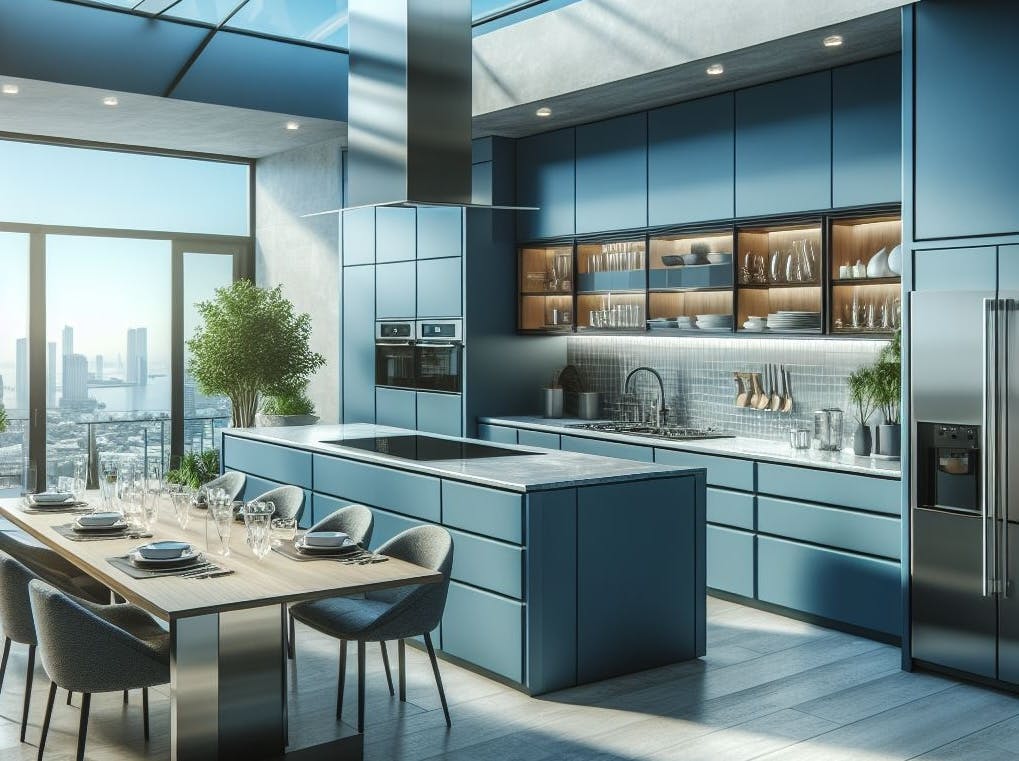Harnessing the Power of Interior AI - The Future of Home Decor



In the realm of interior design, Room Design AI is revolutionizing the way we envision and create our living spaces. This technology is reshaping the landscape of home decor by offering unprecedented levels of personalization, space optimization, and aesthetic harmony.
Key Takeaways
- Room Design AI enhances personalization in home decor.
- AI optimizes space utilization, maximizing the functionality of living spaces.
- Aesthetic harmony in living spaces is achieved through AI-powered design solutions.
- AI tools like virtual reality applications provide immersive room visualization experiences.
- Augmented reality enables interactive and dynamic room planning, enhancing user engagement.
The Impact of Room Design AI on Interior Decor
Enhancing Personalization in Home Decor
The advent of Room Design AI has brought about a new era of personalization in home decor. AI algorithms now understand individual preferences and styles, tailoring design suggestions that resonate with the homeowner's unique taste. This level of customization was once the domain of professional interior designers, but AI has democratized the process, making it accessible to all.
- Collect user preferences and past behavior
- Analyze current design trends
- Suggest personalized decor items
- Offer custom color schemes and layouts
The true beauty of AI in room design lies in its ability to learn and adapt. Over time, it can refine its suggestions to align even more closely with the homeowner's evolving tastes.
By leveraging data from various sources, AI can create a design profile for each user, ensuring that every recommendation is a step towards creating a space that feels like home. The result is a living space that is not only aesthetically pleasing but also deeply personal and comforting.
Optimizing Space Utilization with AI
The advent of AI in room design has brought about a significant shift in how we utilize space within our homes and offices. AI algorithms can now analyze a room's dimensions and suggest the most efficient layouts, maximizing both functionality and style. This optimization goes beyond mere furniture arrangement; it encompasses storage solutions, traffic flow, and even the placement of decorative elements to ensure a space that is both practical and pleasing to the eye.
- AI-driven space planning tools can identify underused areas and propose improvements.
- Smart algorithms suggest multi-functional furniture to save space.
- AI can simulate different layouts, showing potential before any physical changes.
By leveraging data and predictive analytics, AI can create a space that adapts to our living habits, evolving with our needs over time. This personalized approach to space utilization not only enhances the livability of our environments but also contributes to a more sustainable approach to interior design.
Creating Aesthetic Harmony in Living Spaces
The advent of Room Design AI has brought a new dimension to achieving aesthetic harmony in our living spaces. By analyzing numerous design principles and user preferences, AI can suggest color palettes, textures, and furniture arrangements that resonate with the homeowner's personal style. The result is a cohesive and visually pleasing environment that reflects individuality while maintaining design integrity.
- AI identifies complementary colors and materials.
- Suggests optimal furniture placement for flow and visual balance.
- Recommends accessories to enhance the overall aesthetic.
The true beauty of AI in room design lies in its ability to balance form and function, creating spaces that are not only beautiful but also livable and comfortable.
With the help of AI, even those without a background in interior design can achieve professional-level results. The technology empowers users to experiment with different styles and configurations, making the design process more accessible and less intimidating.
AI-Powered Tools for Room Visualization
Virtual Reality Applications in Room Design
The advent of Virtual Reality (VR) has opened up new frontiers in room design, allowing both professionals and homeowners to immerse themselves in a virtual representation of their living spaces before any real-world changes are made. This technology enables a level of detail and realism that was previously unattainable, making it an invaluable tool for interior design planning.
- Experience true-to-scale room dimensions
- Experiment with different decor styles and furniture arrangements
- Visualize the impact of lighting and color schemes
VR room design applications help to eliminate much of the guesswork involved in decorating a space. Users can make informed decisions about their design choices, leading to more satisfying and functional living environments.
The use of VR in room design not only enhances the creative process but also streamlines communication between clients and designers. By providing a common visual ground, it facilitates a clearer understanding of design intentions and expected outcomes.
Augmented Reality for Interactive Room Planning
Augmented Reality (AR) is transforming the way we plan and visualize our living spaces. By overlaying digital information onto our physical environment, AR allows for an interactive and immersive room planning experience. Users can now visualize furniture and decor in their actual space before making any purchases, reducing the risk of design mismatches and buyer's remorse.
With AR, the trial-and-error approach to room design becomes a thing of the past. Instead, individuals can experiment with different layouts and styles with just a few taps on their device.
The benefits of AR in room planning are not just visual; they also extend to practical aspects of design. Here's a list of advantages:
- Real-time visualization of design changes
- Accurate measurement of spaces using AR tools
- Easy sharing of design concepts with others
As AR technology continues to advance, we can expect even more sophisticated tools that will further streamline the room planning process, making it more efficient and enjoyable for everyone involved.
The Future of Room Design: AI Trends and Innovations
Predictive Design Algorithms for Customized Spaces
The advent of predictive design algorithms marks a significant leap forward in the realm of room design. These sophisticated systems analyze vast amounts of data, including user preferences and behavior patterns, to suggest design elements that are likely to appeal to the homeowner. The result is a highly personalized space that resonates with the individual's style and needs.
Predictive algorithms can forecast future trends and help designers stay ahead of the curve, ensuring that a space not only meets the current tastes but also has a timeless quality. The integration of these algorithms into room design tools allows for a seamless and intuitive design experience.
By leveraging machine learning, predictive design algorithms can continuously improve their suggestions, creating a dynamic and ever-evolving design process that adapts to changing lifestyles and preferences.
Here's how predictive design algorithms can transform the design process:
- Data Analysis: They sift through user data to understand preferences.
- Trend Prediction: Algorithms predict and incorporate upcoming trends.
- Customization: Offer tailored recommendations for furniture, color schemes, and layouts.
- Feedback Loop: User feedback helps the system to refine future suggestions.
Integration of Smart Home Technology in AI Design
The integration of smart home technology with AI-driven room design is paving the way for a new era of interconnected living spaces. Smart devices and AI algorithms are now working in tandem to create environments that adapt to our lifestyles, enhancing comfort and efficiency.
- Smart lighting systems adjust to the time of day and activity in the room.
- Intelligent thermostats learn from our habits to optimize temperature settings.
- Voice-controlled assistants manage daily tasks and integrate with other smart home elements.
The synergy between AI design tools and smart home technology ensures that the future of room design is not only about aesthetics but also about creating spaces that are truly attuned to the occupants' needs.
The potential for AI to learn and predict our preferences means that room design can evolve with us, seamlessly integrating technology that anticipates and responds to our behavior. This is not just a step forward in convenience; it's a leap towards a more intuitive and personalized home environment.
Conclusion
In conclusion, the integration of Room Design AI technology is set to revolutionize the way we envision and create our living spaces. By leveraging artificial intelligence, designers and homeowners alike can explore innovative design possibilities, optimize space utilization, and personalize their environments with ease. This transformative technology has the potential to streamline the interior design process, enhance creativity, and ultimately, redefine the concept of home design. As Room Design AI continues to evolve and advance, it promises to shape a future where our living spaces are not just functional, but truly reflective of our individual styles and preferences.
Frequently Asked Questions
How does Room Design AI enhance personalization in home decor?
Room Design AI uses advanced algorithms to analyze individual preferences and style choices, allowing for customized and personalized design recommendations.
What role does AI play in optimizing space utilization?
AI algorithms can suggest efficient furniture arrangements and layout designs based on room dimensions, maximizing the use of available space.
How does AI contribute to creating aesthetic harmony in living spaces?
AI can recommend color schemes, furniture styles, and decor elements that complement each other, ensuring a cohesive and visually appealing design.
What are the benefits of using virtual reality applications in room design?
Virtual reality allows users to experience and visualize room designs in a realistic 3D environment, providing a better understanding of spatial relationships and design concepts.
How can augmented reality enhance interactive room planning?
Augmented reality enables users to overlay virtual furniture and design elements onto real-world spaces, allowing for interactive and immersive room planning experiences.
What are predictive design algorithms in customized spaces?
Predictive design algorithms use data analysis and machine learning to anticipate user preferences and behavior, enabling the creation of tailored and personalized room designs.